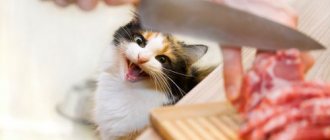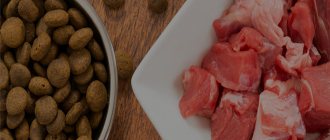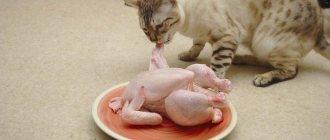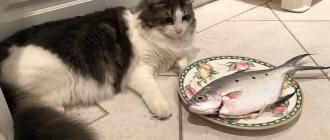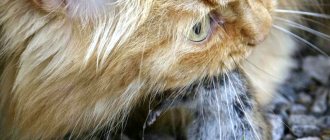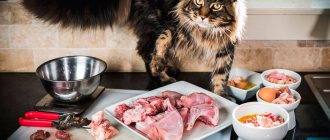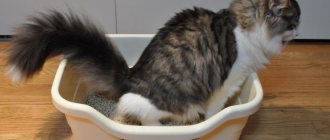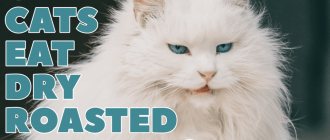About half of the owners feed their cats dry food, forgetting that the original food of predators is meat. In the case of adult animals, this is an acceptable type of feeding, but not in the case of small kittens. The first food they should try after mother's milk is meat, no choice. Therefore, the answer to the question whether kittens can eat meat is a definite “yes.” Now let’s talk about what it should be, how much, when and in what form.
This article is part of the Natural Cat Nutrition section.
What kind of raw meat is suitable for a cat?
Not all meat can be used to feed cats. Some of its types will cause one harm to the animal, causing digestive disorders. Useful for cats:
- beef,
- goat meat,
- horsemeat,
- lean lamb,
- rabbit meat,
- chicken,
- turkey meat.
In addition, offal products, which cats eat especially readily, will also benefit the animal if fed in moderation. However, the owner must remember that their animal can be given no more than 200 g per week (the same applies to fish). You can feed your animal raw foods only if they are well tolerated. Not every cat easily digests offal.
The freshness of the meat is of great importance for the animal. The statement that cats like meat that is not quite fresh and has a smell is nothing more than a misconception. It arose because some owners simply seek to save money on animal nutrition. In fact, bad meat is just as harmful to cats as it is to humans.
Possible problems
Sometimes kittens have problems when feeding meat. Let's list the most typical ones.
Kitten vomits raw meat
If a kitten vomits raw meat, then most likely he ate too much at one time. Some kittens do not know how to control their eating behavior, attacking food like crazy and eating everything they see. Such kittens should be limited by giving food in strictly measured portions. Even if it seemed to you that the kitten vomited after eating a small amount of meat, perhaps you were just measuring by eye and that’s why its portion seemed small. So use a kitchen scale.
Also, the cause of regurgitation may be intolerance to any type of meat. Pay attention to what exactly the kitten regurgitates. If it is always the same type of meat, you will have to give it up.
In addition, regurgitation of hard food such as gizzards or bones may occur.
In addition, if the kitten is 2-3 months old or more, and he is accustomed only to industrial food, problems associated with enzyme deficiency may arise with the consumption of meat.
EXPERT COMMENT: CANDIDATE OF BIOLOGICAL SCIENCES GALINA CHILIKINA
“Any dry food is granules that have a porous structure and contain almost digested food, so enzymes are not required to digest dry food. Entering the stomach through the esophagus, these granules begin to absorb gastric juice, under the influence of which they turn into a homogeneous liquid gruel, which in turn enters the small intestine, where absorption occurs. The movement of this liquid gruel from the stomach into the intestines occurs almost by gravity, so contraction of the walls of the stomach and intestines is not required. Therefore, the motility of the gastrointestinal tract in cats eating exclusively dry food is very sluggish. Thus, dry industrial food takes over the functions of the body, and this leads to the fact that the cat does not produce enzymes intended for breaking down and digesting natural food.”
Kitten eats only meat
This is normal, no need to worry. The kitten is a predator, it is supposed to eat meat. All other products (fermented milk, fish, vegetables, eggs) are food additives that may not be in the diet. And even more so, do not feed kittens cereals that are harmful to them.
Kitten doesn't want to eat meat
But this situation, on the contrary, requires careful study. All kittens, when they reach the age of 1 month, are already able to absorb some amount of meat. After all, at 2 months they will have to wean themselves from their mother’s breast and eat on their own. If a very small kitten refuses meat, then it is simply too early for him to eat it. If we are talking about a 2-month-old kitten, then it needs to be examined. Typically, this behavior is associated with gastrointestinal pathologies.
Some cats refuse to eat meat if they have been taught to eat dry food. Adult cats can sometimes be very difficult to retrain. But with kittens that previously ate dry food, as a rule, there are no problems when switching to meat. Kittens are open to everything new and it is quite simple to form in them the food preferences needed by the owner.
Can I feed it chicken?
This is what we are guided by when we feed our pet such products. However, we forget that the meat we buy on store shelves is not as healthy as what an animal eats living on the street. So what to do? Go hunting? Not at all! It’s enough to just figure out which meat will be useful for a cat and which not so much.
- Chicken is harmful to cats, as it is most often stuffed with antibiotics and various growth hormones, and is also. It will have to be abandoned. Chicken skin won't do him any good either.
- Turkey is an excellent substitute for chicken meat, and it contains many times more vitamins and healthy ingredients.
- Pork is a very “heavy” food product not only for humans, but also for cats, which can cause stomach upset and indigestion. It also leads to the pet becoming infected with worms, and in some cases, other dangerous infectious diseases.
Attention!
Pork contains a large amount of fats that are harmful to the pet’s body.
- Beef will be an excellent alternative to pork. Even veterinarians recommend giving cats this treat.
- In some cases, you can diversify a cat's diet with rabbit meat, but this should be done rarely and with caution. Let rabbit meat be a kind of delicacy for the cat.
The most important thing when choosing a food product:
- Freshness. Under no circumstances should you give your pet spoiled food. The meat must be fresh and of high quality.
- Temperature. It is not recommended to eat meat only from the refrigerator, much less from the freezer, but you also don’t have to reheat it, because hot food is also not allowed. It is enough to let it sit for a while at room temperature.
- Fat content. As already mentioned, cats don’t need excess fat. When serving meat to a cat, you need to get rid of the veins and fat.
- You need to choose only clean meat, without tendons and bones. Give preference to sirloin parts. Don’t forget to include by-products in your pet’s diet: liver, kidneys, heart. This should be done rarely and in small quantities.
Important!
Veterinarians have long argued that chicken meat is harmful to cats.
Chicken, raw and cooked, has a harmful effect on the liver of animals.
Frequent use of it can cause irreversible changes in the organ and develop some diseases, in particular pancreatitis and urolithiasis.
In addition, chicken bones, when they fall apart, have very sharp pieces and pose a risk of mechanical damage to your pet.
If your cat “can’t live” without chicken, then give her a small amount of natural poultry, or rather, its loin.
Not all meat can be included in a cat’s diet, even if it is of very high quality. In nature, animals can eat all types of meat and therefore hunt a wide variety of game. Domestic cats living in comfort already have a different metabolism, and therefore a number of foods can cause them harm and should not be given. A cat can get sick if its diet includes the following meat:
- pork;
- any fatty meat;
- duck;
- goose.
We invite you to familiarize yourself with: Breeds of chickens Pushkin chickens
The following products are prohibited:
- Fresh steam. Unprocessed meat is a potential source of harmful bacteria, helminth larvae and eggs.
- Salty. Salt disrupts the balance of minerals and retains fluid.
- Roast. Excess oil upsets metabolism.
- Canned. To increase shelf life, components harmful to cats are included: salt, seasonings, spices.
- Smoked. Wood smoke contains volatile carcinogens. When smoking for industrial purposes, meat is doused with an artificial liquid, which corrodes the gastric mucosa and causes an allergic reaction.
- Dried. The product is kept in a marinade with additives harmful to animals: salt, vinegar, spices, garlic.
- Meat waste. Bones, paws, and heads injure the digestive organs; cats do not digest chicken and turkey skin. The trimmings are taken from the surface of the piece, and therefore contain pathogenic microbes.
- Pieces larger than 2 cm. Large pieces are difficult to chew, which is why nutrients are less absorbed.
- Meat puree. A cat's teeth need stress; if you constantly feed them soft food, they are destroyed. The puree is suitable for kittens or adult animals with digestive tract problems.
| View | Harm to the cat |
| Pork | A protein to fat ratio of 14:33 is not good for a cat. Contains histamines. Possible source of parasites. |
| Goose | The muscle tissue of birds older than six months becomes tough and difficult to digest. Fat content reaches 38%, calorie content 369 kcal. |
| Mutton | Difficult to digest, high fat content. |
| Duck | In terms of calories and fat, it is comparable to goose. |
| Fresh liver | Poorly absorbed, causes diarrhea. |
| Raw chicken | There is a risk of salmonellosis infection. |
| Pork by-products | They have the same negative qualities as meat. |
| Raw lung | Not digestible, poor composition of nutrients. |
| Store-bought minced meat | Contains fat, skin. |
| Necks of domestic chickens | The vertebrae are too hard for cats. |
A one-time inclusion of fatty meat in your diet will not harm. With constant feeding, the animal develops problems. First, weight increases, and against the background of obesity, cardiovascular diseases and diabetes develop.
Composition and nutritional value of beef
The name of the product comes from Ancient Rus', where the word “beef” meant “cattle”.
Therefore, now the clean, undecomposed flesh of cows, bulls or oxen is called beef. It contains (per 100 g):
- water – 72-74 g;
- protein – 15-19 g;
- fats – 3-5 g;
- carbohydrates – 0.002 g;
- ash – 1 g;
- sugar and fiber – 0.
The nutritional value of such a slice is approximately 133 kcal.
The meat contains cholesterol in the amount of 64 mg and a small amount of trans fats - 0.2 g. Vitamin composition:
- fat soluble A, D, D3, E and K;
- water soluble B1, B2, B3 (PP), B4, B5, B6, B9 and B12.
The mineral content of beef is as follows (in mg per 100 g):
Vitamins and microelements in beef.
- potassium – 342;
- calcium – 10;
- magnesium – 27;
- sodium – 55;
- sulfur – 230;
- phosphorus – 211;
- chlorine – 59;
- iron – 2.5;
- iodine – 0.0072;
- cobalt – 0.007;
- manganese – 0.035;
- copper – 0.00182;
- molybdenum – 0.00116;
- nickel – 0.0086;
- tin – 0.0757;
- fluorine – 0.063;
- chromium – 0.082;
- zinc – 3.24.
Why raw meat can be dangerous
The harm of the fresh product is associated with possible infection with helminths and harmful microbes.
These include:
- Campylobacter lives in the intestines of animals and birds and causes the acute intestinal disorder campylobacteriosis.
- The “false rabies” virus is contained in pork; when infected, convulsions, paralysis, and itching begin.
- Escherichia coli, pathogenic strains provoke acute poisoning.
- Salmonella is most often found in chicken. Bacterial toxins cause vomiting, diarrhea, and dehydration.
- Brucella enters the body with the milk and meat of sick animals. The bacterium affects nerve cells, blood vessels, and genitourinary organs. Brucellosis is not completely cured.
- Trichinella is found in pork. After entering the intestines, they penetrate the walls, spread through the bloodstream, and settle in the muscles. Trichinosis is fatal if there are more than 5 larvae per 1 kg of weight in the body.
It is better not to buy products in dubious places where the quality of the goods is not controlled.
Danger of raw product
First of all, it contains a huge number of small bones. In addition, it is most often infected with helminths, which, when entering the cat’s body, cause the dangerous disease opisthorchiasis. Therefore, it is better to give sea and ocean fish.
It is enough to give your cat a “fish day” a couple of times a week by adding a few pieces of frozen or lightly cooked fish to the diet. You should not give a lot of this product, since substances in fish actively break down vitamin B1, so if there is an abundance of fish in the diet, a deficiency may occur.
The best choice for murk is beef. Lamb, for example, contains a large amount of fat and should not be fed to animals. For cats that need dietary nutrition, a rabbit is suitable. Chicken is an acceptable product. Chicken meat should be alternated with beef. Turkey is also suitable, but in combination with beef and chicken. Duck cannot be fed to pussies due to the high fat content of the meat.
By-products are a must. Boiled liver, like other offal, should be introduced into the diet gradually and in small portions. This can be done when the cat reaches one year of age.
Chicken heads are not the best food for cats, as they contain a lot of bones that can clog the esophagus. It is better to replace the heads with boiled necks. As for chicken, you should be careful not to include long bones, as they are sharp and can damage the digestive tract. Any fatty meat, skin, beaks, claws are prohibited.
We invite you to read: White broad-breasted turkey: description of the breed
Now let's talk about why domestic cats should not be given pork.
The fact is that pork contains a lot of fat. In addition, it should not be given raw, as it can be a source of fluke infection and false rabies.
Raw meat for a cat can pose one danger - worms. These intestinal parasites lead to a deterioration in the cat's condition. If they are not destroyed in a timely manner with the help of special preparations, there is a risk of severe intoxication in the animal, which can sometimes lead to death without urgent veterinary care.
When meat and offal go on sale, they are not checked for all parasites. The eggs of some worms are not detected due to the fact that the animal was infected shortly before slaughter and clear signs of the presence of parasites have not yet appeared.
Is it possible for a cat?
Eating disorders after introducing a new food into the diet often occur due to stress. Therefore, you should not immediately exclude turkey from your pet’s menu.
According to research by felinologists, turkey meat can be eaten by pets, since this meat is lean, contains up to 50% protein from muscle fibers and is rich in vitamins, macro- and microelements. Chicken or beef are less healthy for the animal. The fresh product is easily digestible, so it can be eaten even by cats with impaired functioning of the gastrointestinal tract. Preference should be given to fillet, as it does not have bones that are dangerous to cats. At the same time, instant products containing turkey are prohibited due to their high salt content and food additives to enhance the taste and increase shelf life. The energy value of semi-finished products is minimal, in contrast to nutritious fresh meat products grown in environmentally friendly conditions.
How to keep meat safe
Bacteria, parasites, and viruses die at high and low temperatures; to reduce the risk of infection, the following methods are used:
- Freezing. In home refrigerators, at minus 18℃, parasites die in 4 days. This does not apply to trichinella and salmonella; frost does not affect them.
- Cooking. In boiling water, viruses and bacteria die within 1 – 20 minutes; it will take 3 hours to destroy Trichinella.
When scalded with boiling water, bacteria are destroyed from the surface; this method will not protect against helminthiasis. Meat is not kept next to other food; a separate knife and cutting board are allocated for it.
To prevent your cat from becoming infected with worms by eating meat, the product must be well prepared beforehand. The owner won’t have to do anything complicated. In order to destroy parasite eggs, their larvae and even adults, it is enough to freeze the meat for 50 hours. No matter how resilient worms are, they cannot withstand prolonged exposure to sub-zero temperatures. After cooling, the meat becomes completely safe and can be given to your cat without worrying about its health.
Benefits and harms
Veterinarians recommend weighing the following pros and cons presented in the table before including turkey meat in your cat’s diet:
| Positive characteristics | Negative consequences of use |
| High protein content | Excessive fat content in the skin |
| Low levels of dangerous fats | Risk of parasite infection due to insufficient heat treatment |
| High concentration of taurine | Possibility of poisoning with nitrates and antibiotics |
| Quick saturation of the body | High content of dangerous long bones |
| Minimal likelihood of allergies | Spoiled turkey causes gastrointestinal upset |
What kind of meat to give: boiled or raw
Often, owners give their pets both raw and cooked meat. It should be noted that cats eat boiled food more readily. You can feed your cat both raw and cooked meat, but you cannot combine such foods in one feeding, since different enzymes are needed to digest raw and cooked meat, so you can overload the animal’s gastrointestinal tract.
Lyn Thomson, BVSc DipHom, 2014
Many cat lovers who adopt small kittens are interested in the question of whether it is possible to give the kitten raw meat until the milk teeth have been replaced by permanent ones. Do I have to wait until the teeth are completely replaced before they can eat small pieces of meat with bones?
It is clear that the diet of kittens should be different from the diet of adult cats. Ideally, by the time they are weaned, kittens should be accustomed to eating raw meat, as they do in the wild. Kittens, once weaned from their mother's milk, should be able to eat meat on the bones, so they should begin learning to gnaw and chew as early as possible. If you want to feed your cat natural food, then keep in mind that it is much easier to teach a kitten to eat meat than to retrain an adult cat.
Meat with bones is a natural source of calcium that is approximately four times more efficiently absorbed than calcium from supplements. If you feed your cat clean meat, it is necessary to ensure the correct ratio of calcium and phosphorus, since fresh meat contains a lot of phosphorus. Meat on the bones is an excellent choice, since nature has already created the necessary balance - calcium and phosphorus in this case have an optimal ratio, so you do not have to worry about additional nutritional supplements.
Raw bones also contain small amounts of cartilage, bone marrow and minerals necessary for the proper development of the kitten. A sufficient amount of coarse tissue has a good cleansing effect on the gastrointestinal tract and ensures regular emptying of the anal glands.
In addition, eating meat is the key to the development of healthy teeth and gums. When chewing meat and bones, the teeth and gums are massaged, food debris is removed, and the formation of tartar is prevented. This massaging action is vital during teething. Many kittens fed pelleted food experience gum problems at four to five months of age (soreness, inflammation), when their permanent teeth erupt.
Kittens' baby teeth form between four and six weeks of age. From this time on, they can already cope with soft pieces of meat and minced meat and bones. Kittens should receive meat every day, and after weaning from the cat, meat on the bones should be their main food. Rabbit bones are best suited for kittens, especially shoulder bones, chicken necks and wings.
We suggest you read: Why does a cat eat soil: reasons for strange behavior
Remember that raw, meaty bones are nutritionally balanced. Avoid cooked bones as they can splinter and cause gastrointestinal problems.
It is best to give raw meat and only occasionally replace it with boiled meat. You've probably noticed that cats prefer raw meat. Such meat also contains more vitamins than boiled meat. But no one canceled heat treatment!
Reference!
Meat, if not cooked, must be pre-frozen in the freezer and then defrosted. Before serving, it must be scalded with boiling water.
The raw product can be given in its pure form, but it is better to mix boiled meat with vegetables so that the pet does not have problems with the digestive system.
Important!
Never give fried meat to cats! Salt, spices, fat and substances released during frying will not benefit the fluffy.
Fresh meat is better digestible and retains nutritional components. Boiled is safer, cats often eat it more willingly, but the taurine and vitamins are partially washed out.
Both types are allowed if prepared correctly:
- Do not serve raw without first freezing.
- When cooking, add a minimum of water or simmer in its own juice.
- Freeze the liver, chop it and scald it with boiling water.
- Do not combine fresh and cooked food in one feeding; different enzymes are required for absorption.
Meat is the main food of a cat's diet, but not all types are suitable for feeding a cat; it becomes useful only after processing.
It’s not uncommon for owners to give their cats not only raw, but also boiled food, since many pets eat cooked meat more readily. Boiled meat contains enough nutrients for a cat, and if desired, you can feed it such a product in combination with raw meat, but only without combining them in one feeding.
The fact is that if a cat eats raw and cooked meat at the same time, then in order to digest two dishes at once, the production of different enzymes will be required. This can overload the cat's digestive system, causing diarrhea or vomiting. The interval between giving food should be at least 3 hours.
In what form can you give beef to your pet?
You can feed your cat beef raw or boiled.
Raw meat
For natural predators it is natural food. All useful substances are completely preserved in the raw product. The smell attracts the cat, and the fibrous elastic structure has a beneficial effect on the development of chewing muscles.
Raw beef has the optimal texture for cats.
However, such food is almost never found in nature. During the hunt, the pet catches a mouse or bird, eating fur, bones, blood mass, and skin along with the meat. These poorly digestible components improve bowel function. Thus, purchased beef differs from the food that the animal’s body is tuned to. Therefore, there is no need to limit your cat’s diet to only this type of meat. Along with it, you need to give food rich in fiber, protein, minerals and vitamins.
Boiled
During heat treatment, along with microbes and bacteria, the amount of useful elements in beef decreases. Sometimes, instead of cooking, owners scald the meat with boiling water. However, if it contains parasites, this method cannot guarantee complete cleansing of larvae and microorganisms.
Boiled meat will not harm your cat, but it prefers raw meat.
What meat is healthier to give to a cat?
In the video you can see more details about feeding raw meat to cats.
Can a cat eat raw meat? Opinions for and against.
Raw meat is good for your cat's health. It contains all the amino acids and proteins necessary for the animal and ensures the proper functioning of internal organs and systems. Also, in its raw form, the product is much easier to digest by the pet’s stomach, and therefore the cat does not risk getting diseases of the digestive system.
It is strictly forbidden to give your cat fried and smoked meat. Such products will only harm the health of the animal. There is nothing useful in them for the cat, but they cause irritation of the stomach and liver. Also, if the pancreas is weak, it may also suffer.
Composition of turkey: why is it so healthy?
Poultry contains almost no fat and cholesterol, which are dangerous for pets, and is also rich in the following beneficial elements:
The optimal level of hemoglobin in the animal’s blood can be maintained by iron, which this product is rich in.
- Retinol. The vitamin enhances the animal’s natural immune defense, prevents pathologies of the visual apparatus and stimulates tissue regeneration.
- Tocopherol. A natural antioxidant prevents disturbances in the functioning of the pet’s reproductive system and improves overall well-being.
- Cu and P. Microelements strengthen bone tissue and dental apparatus.
- Polyunsaturated fatty acids. Omega-3 and 6 improve the condition of the coat and skin.
- Fe. Iron supplied from outside maintains normal hemoglobin levels in the blood.
- Taurine. Sulfonic acid, which the cat’s body cannot synthesize on its own, supports the normal functioning of the visual organs.
What is the best way to feed meat?
Feed your cat raw meat every day, best in the morning, when her body is most active and absorption will proceed fairly quickly. The product should not be given in large pieces, because if the pet does not chew it and swallows it almost entirely, the cat will vomit. Cut the meat into cubes 15 by 15 mm. The juice that appears after defrosting the meat can be given to the cat, since many animals love to lap it up.
In order for the feeding to be complete, you should not give only meat. For one serving you need to take:
- 75 g of meat (optimally feed raw beef),
- 1 tablespoon olive oil;
- 25 g of vegetable puree made from steamed carrots, zucchini or cabbage.
Don't listen to the myth that raw meat and cats are incompatible. In fact, meat nutrition for an animal is the most natural and correct
Can cats be given turkey?
Veterinarians allow boiled turkey to be given to cats, as it is a very healthy dietary meat with a high content of taurine and vitamins. However, this product cannot be given every day, so it is better to alternate it with dry food, chicken or beef. It is important to remove small tubular bones, which can damage the animal's esophagus and lead to death. When changing the diet, if the pet has not eaten poultry before, you need to make sure that an allergic reaction does not occur.
